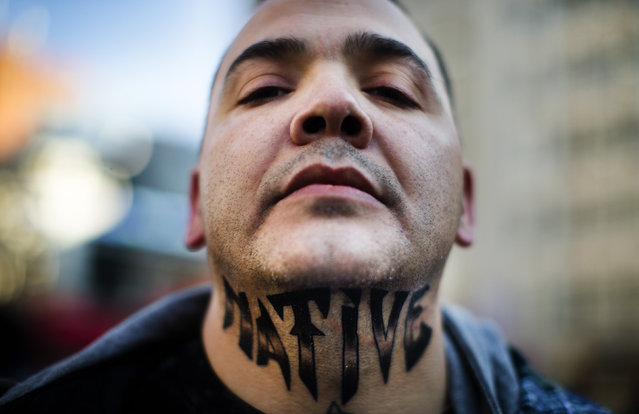
First Nations protester Leo Marcel Neveu poses to show his tattoo which reads “Native” on his neck as he takes part in the “Idle No More” demonstration in Toronto, January 16, 2013. (Photo by Mark Blinch/Reuters)
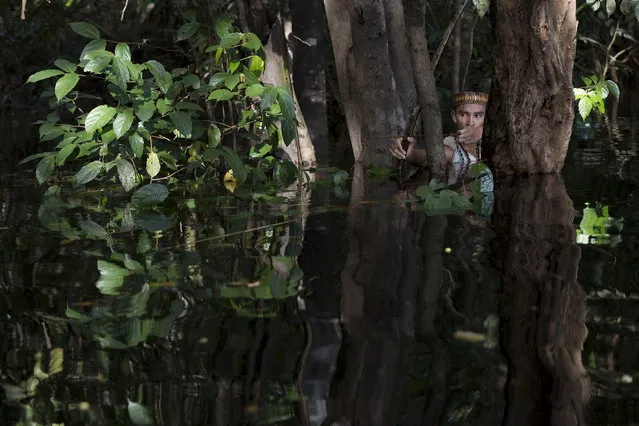
Kambeba Indian, Dream Braga, has been shooting fish with a bow and arrow for most of his life. In the Amazonian village where he grew up, that was what kids did for food and fun. He participated in the Indigenous Archery Project which recruits Amazon native children to compete with modern archery equipment and try for a place on the national team, with the 2016 Olympics in Rio de Janeiro as their ultimate goal. After training with Olympic coaches for three months, he has been promoted to Brazil's national team. (Photo by Bruno Kelly/Reuters)
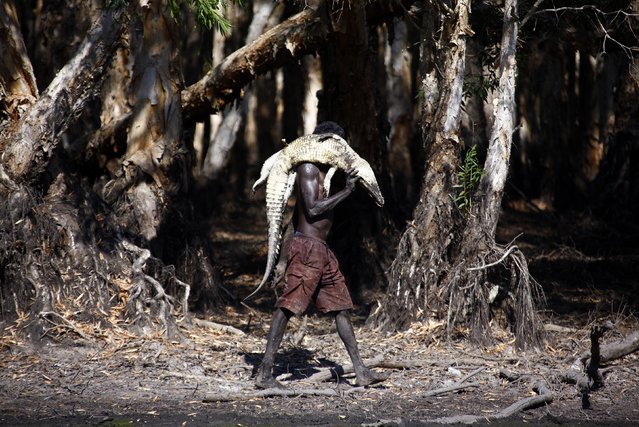
Australian Aboriginal hunter Roy Gaykamangu of the Yolngu people carries a crocodile he has just shot dead along the edge of a billabong near the “out station” of Yathalamarra, located on the outksirts of the community of Ramingining in East Arnhem Land November 22, 2014. The Arnhem Land reserve, closer to Bali than Sydney, covers an area of around 97,000 sq kms (37,000 sq miles), has a population of around 16,000 and access for non-Aborigines is by invitation only. Australia's aborigines are the custodians of the longest unbroken cultural tradition on earth, having migrated Down Under from Africa via Asia between 40,000 and 60,000 years ago, and connection to the land is practically written into their DNA. (Photo by David Gray/Reuters)
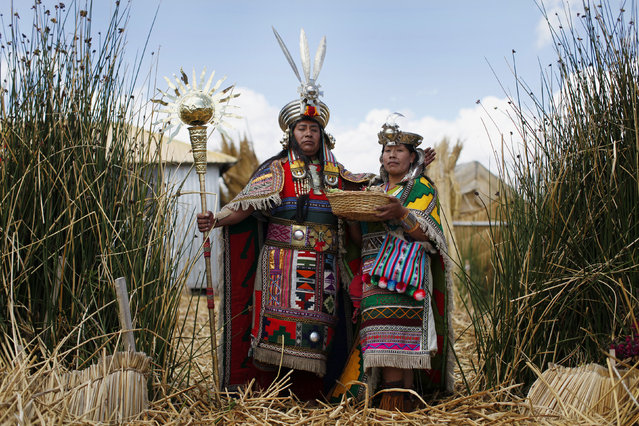
An Andean man and a woman, depicting Inca's legendary characters Manco Capac and Mama Ocllo, pose for a portrait in a Uros island at Lake Titicaca, Peru November 5, 2014. (Photo by Enrique Castro-Mendivil/Reuters)
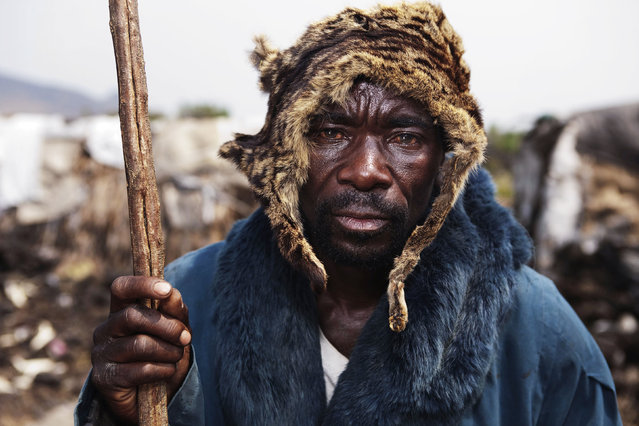
Nzamburba, 57, who is a member of a pygmy community, wears the skin of a wild cat on his head at Mugunga, just west of the eastern Congolese city of Goma, August 24, 2010. (Photo by Finbarr O'Reilly/Reuters)
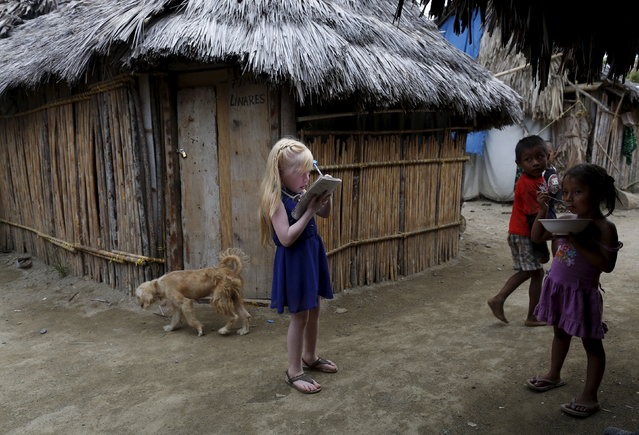
Delyane Avila, 6, who is part of the albino or “Children of the Moon” group in the Guna Yala indigenous community, draws on her notebook next to neighbors on Ailigandi Island in the Guna Yala region, Panama May 4, 2015. Alabaster-skinned people born on a sun-scorched group of islands off Panama's Caribbean coast are venerated as Children of the Moon. Albinos make up between 5 and 10 percent of the roughly 80,000 indigenous Gunas who live on the mainland of the Guna Yala region and its islands. With their sensitive skin and eyes, young Guna albinos must be shuttled to and from school, avoiding the baking heat, while they watch their friends play in the streets. (Photo by Carlos Jasso/Reuters)
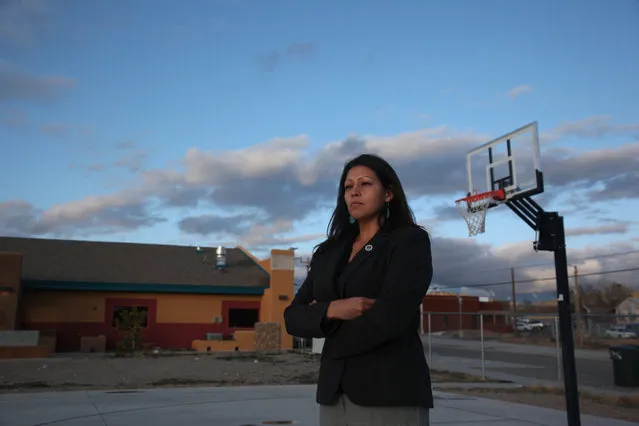
Candida Hunter, Hualapai Tribe councilwoman, poses for a photograph near new buildings on the Hualapai Indian Reservation in Peach Springs, Arizona February 28, 2012. The tiny Hualapai nation, in a bold move that could serve as a test of the limits of the sovereign power of Native American tribes over non-members, exercised its right of eminent domain to take over the management of the site and kick out the non-Indian developer. (Photo by Robert Galbraith/Reuters)
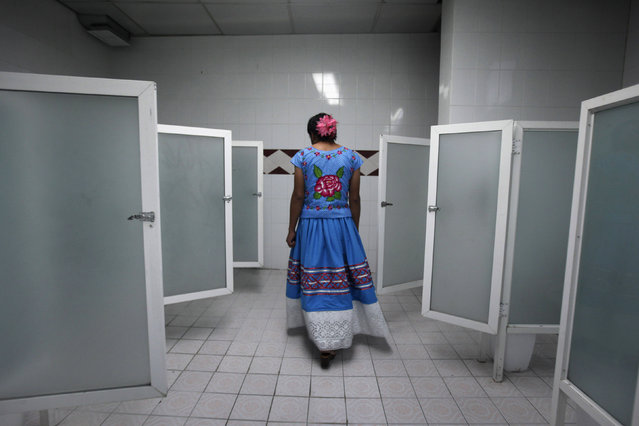
Roberto, a man dressed as a traditional Zapotec also known as “Muxe”, walks inside a women's bathroom during a traditional party in Mexico City, June 29, 2013. Anthropologists say the tradition of blurring genders among Mexico's indigenous population is centuries old but has been revived in recent decades due to the gay pride movement. The muxes, mostly of ethnic Zapotec descent, are widely respected in southern Mexico. (Photo by Edgard Garrido/Reuters)
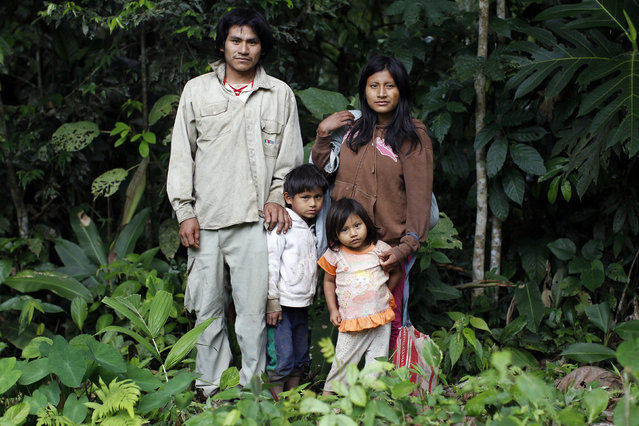
Machiguenga indigenous people Antonio Aguilar (L) and Jesica Araoz pose with their children Manuel and Betsabe close to their home in Shipetiari, a village near the Alto Madre de Dios River, May 25, 2014. Isolated Peruvian tribes like Mashco Piro have clashed in the past with loggers, poachers and drug traffickers who invaded their jungle enclaves, but anthropologists say the lure of modern tools is now tempting them closer than ever to far-flung villages and tourist camps. Their sorties are dangerous, exposing them to the threat of violent encounters with terrified locals and modern-day diseases against which the hunter-gatherers have little immunity. (Photo by Enrique Castro-Mendivil/Reuters)
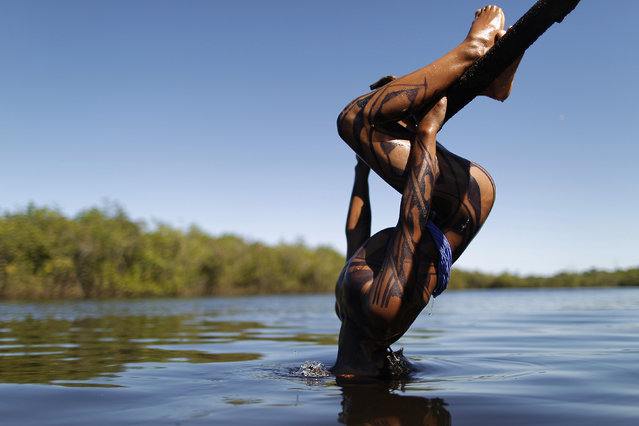
A Yawalapiti boy dips his head into the Xingu River in the Xingu National Park, Mato Grosso State, May 9, 2012. (Photo by Ueslei Marcelino/Reuters)
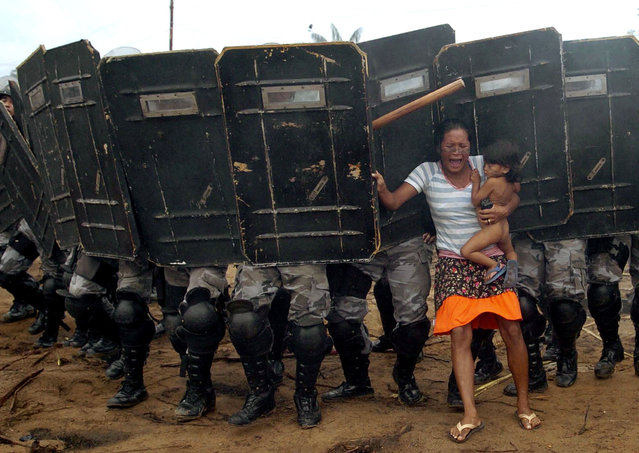
An indigenous woman holds her child while trying to resist the advance of Amazonas state policemen who were expelling the woman and some 200 other members of the Landless Movement from a privately-owned tract of land on the outskirts of Manaus, in the heart of the Brazilian Amazon March 11, 2008. The landless peasants tried in vain to resist the eviction with bows and arrows against police using tear gas and trained dogs. (Photo by Luiz Vasconcelos/Reuters)
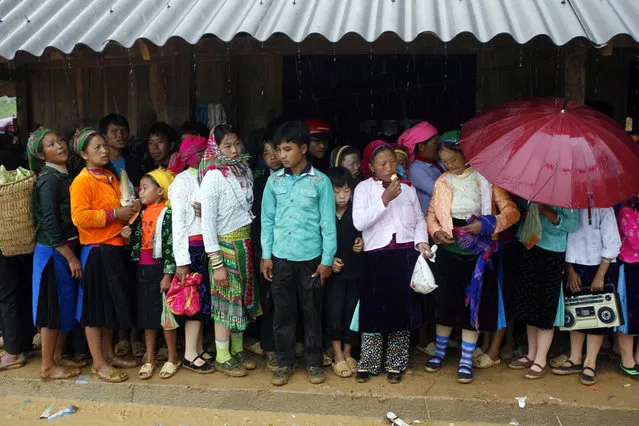
Ethnic Hmong wait for their lovers at the Khau Vai “love market” in Vietnam's northern Ha Giang province, 500 km (310 mi) north of Hanoi May 10, 2010. For nearly a hundred years, the Khau Vai love market has been known as a lovers' rendezvous. Local residents annually gather there from March 26 to March 27 of the lunar calendar to seek lovers. Married men and women wait for the return of their former lovers with whom they can meet again without jealousy from their spouses during this one day out of the year. Single young men and women also seek lovers at the market. (Photo by Reuters/Kham)
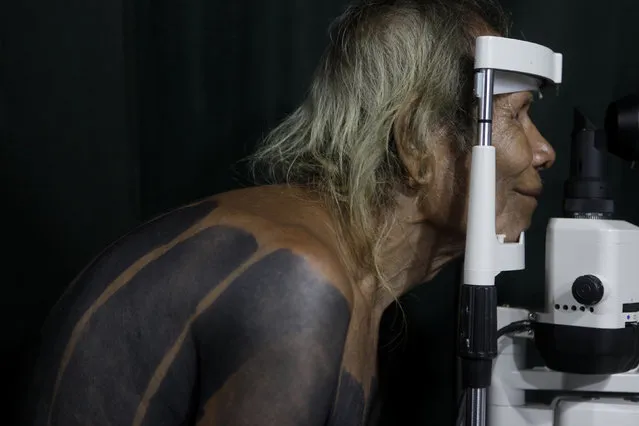
Kypato Kayapo, chief of Kayapo tribe from the Aukre community, receives post-cataract surgery ophthalmologic attention on the seventh day of the “Expedicionarios da Saude” (Brazilian Health Expeditions) medical expedition in the Kikretum community in Sao Felix, northern Brazil, April 27, 2011. (Photo by Ricardo Moraes/Reuters)
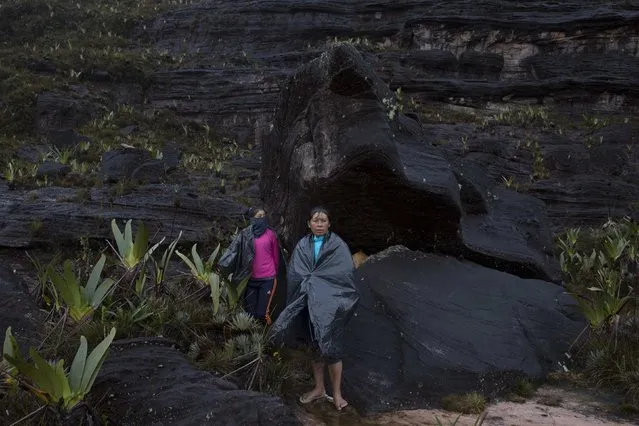
Pemon indigenous porters cover themselves from the rain with plastics bags on top of Roraima Mount, near Venezuela's border with Brazil January 16, 2015. A mysterious table-topped mountain on the Venezuela-Brazil border that perplexed 19th century explorers and inspired “The Lost World” novel is attracting ever more modern-day adventurers. Once impenetrable to all but the local Pemon indigenous people, now several thousand trekkers a year make the six-day hike across Venezuela's savannah, through rivers, and up a narrow path that scales Mount Roraima's 600-meter cliff-faces. While that is a help to Venezuela's tottering tourism industry and brings revenues to local communities, it is also scattering a prehistoric landscape with unwanted litter. (Photo by Carlos Garcia Rawlins/Reuters)
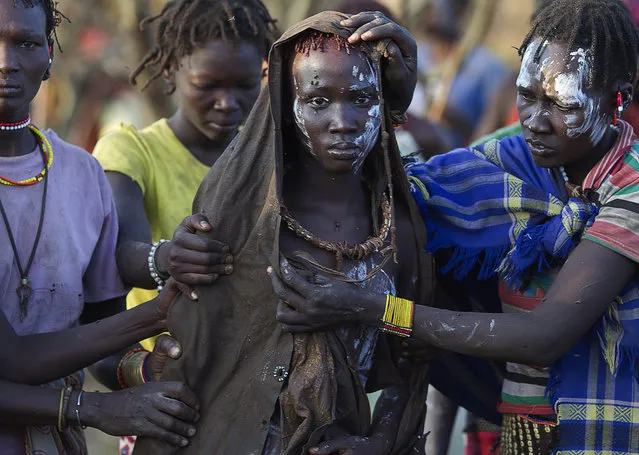
A Pokot girl, covered in animal skins, walks to a place where she will rest after being circumcised in a tribal ritual in a village in Baringo County, Kenya, October 16, 2014. The traditional practice of circumcision within the Pokot tribe is a rite of passage that marks the transition to womanhood and is a requirement for all girls before they marry. More than a quarter of girls and women in Kenya have undergone genital cutting, according to United Nations data. Despite a government ban on the life-threatening practice since 2011, the long-standing tradition remains a rite of passage, particularly among poor families in rural areas. (Photo by Siegfried Modola/Reuters)
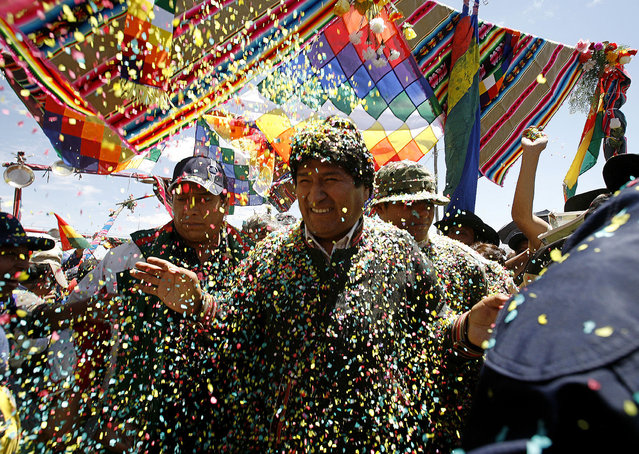
Bolivia's first indigenous president Evo Morales greets supporters upon his arrival to Caracollo town, some 190 km (118 miles) south of La Paz October 13, 2008. (Photo by David Mercado/Reuters)
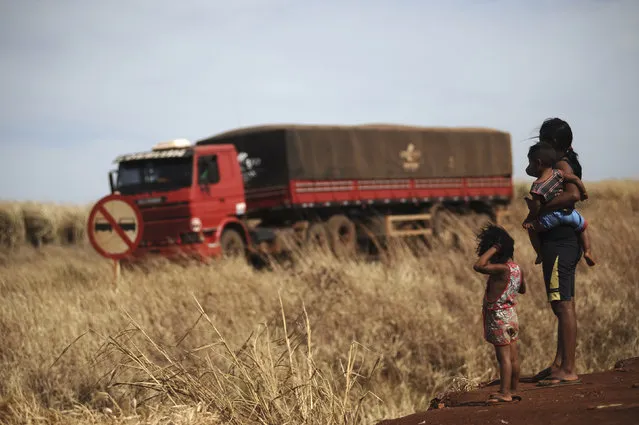
Guarani Kaiowa Indian Dilcia Lopes and her children watch a truck pass from their makeshift camp squeezed between highway BR 463 and their ancestral land called Tekoha Apika'y, where they have been since 2009 when they last failed to take back the land from farmers, near Dourados, Mato Grosso do Sul state, August 8, 2013. The Guarani tribe is immersed in a bloody conflict with farmers over possession of their ancestral land that has characteristics of a territorial war, in spite of Brazil's indigenous policy being considered one of the most progressive in the world. The conflict highlights the risks being run by an agricultural superpower whose leftist government is trying to sort out centuries of ethnic disputes over ownership of the land from which much of the nation's wealth sprouts. (Photo by Lunae Parracho/Reuters)
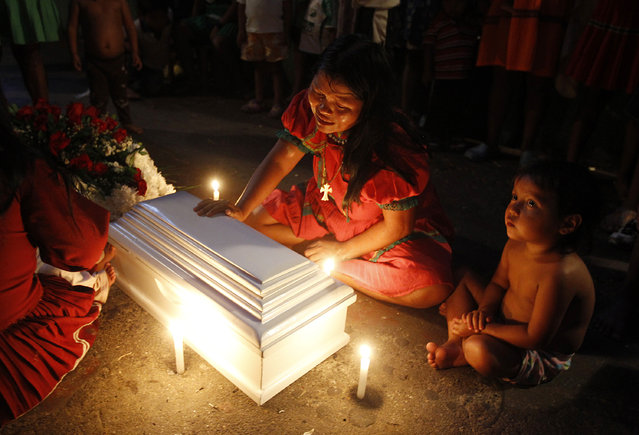
Luz Elaida Queragama, an indigenous Embera Katio, cries beside the coffin of her four-month-old daughter who died in Cali January 25, 2015. Queragama discovered that her baby was not breathing. Members of the displaced Katio community came to Cali in 2013 following an armed conflict that was raging in Pueblo Rico, Risaralda. They now live in poverty in Cali, in three houses that are inhabited by 43 families, authorities said. (Photo by Jaime Saldarriaga/Reuters)
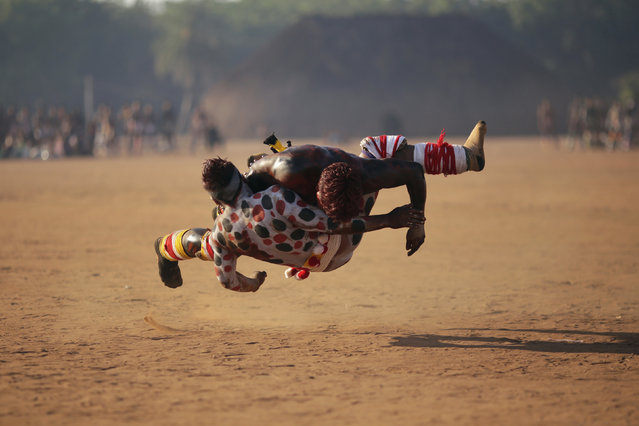
Waura Indians wrestle during this year's “quarup”, a ritual held over several days to honour in death a person of great importance to them, in Xingu National Park, Mato Grosso State, Brazil August 25, 2013. (Photo by Ueslei Marcelino/Reuters)
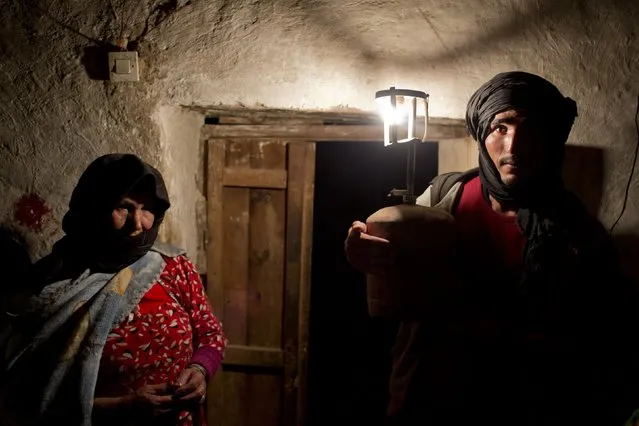
Villager Ali and his mother pose for a photograph in his front room in Ait Sghir village in the High Atlas region of Morocco February 13, 2015. The snowy foothills of the High Atlas mountains in Morocco are home to several Berber villages where the inhabitants make their living by farming, baking bread in traditional ovens, herding cattle, and the making and selling of honey, olive oil and pottery. Extreme weather fluctuations and erosion that causes flooding and landslides have led to a drop in agricultural productivity, the United Nations said. (Photo by Youssef Boudlal/Reuters)
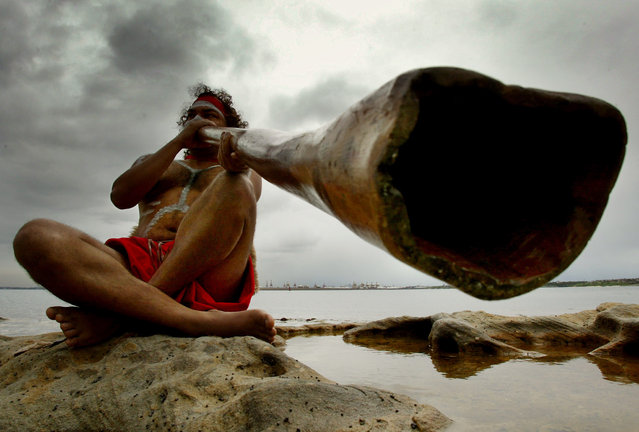
Aboriginal peformer Les Saxby plays a traditional aboriginal musical instrument known as a didgeridoo on the shores of Sydney's Botany Bay April 29, 2002. (Photo by David Gray/Reuters)
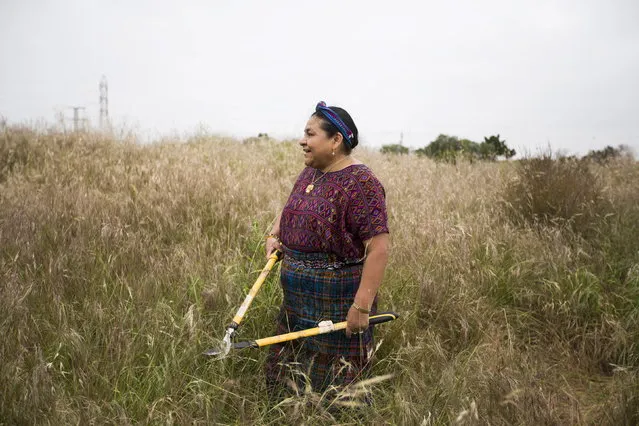
Indigenous Guatemalan Nobel Peace laureate Rigoberta Menchu holds a bypass looper shear while working in a habitat preservation and native plant restoration project for endangered burrowing owls with Google employees in Mountain View, California April 20, 2015. (Photo by Stephen Lam/Reuters)
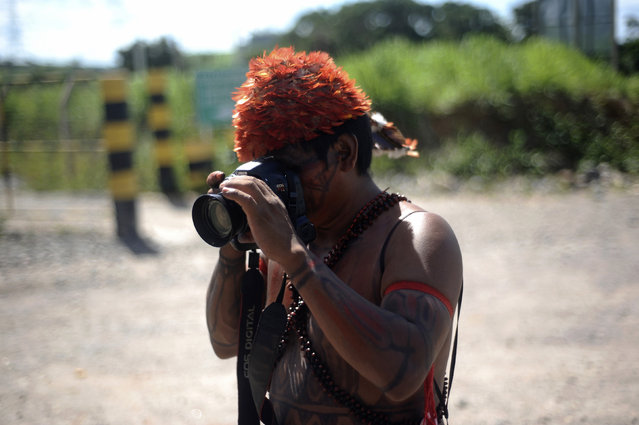
A Munduruku Indian named Paygomuyatpu takes photos with a camera left for him to use by a journalist who was expelled from the Belo Monte hydroelectric dam construction site, in Vitoria do Xingu, near Altamira in Para State, Brazil, May 5, 2013. (Photo by Lunae Parracho/Reuters)
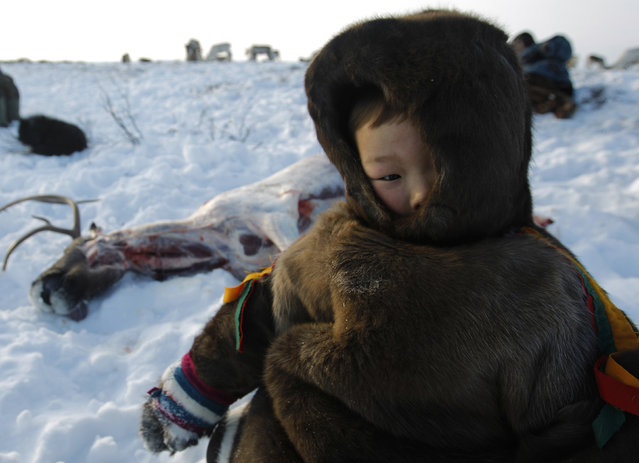
Nenets boy Viktor Lednev sits on the snow, near a carved reindeer at a settlement, about 85 km (53 miles) southeast of the town of Naryan-Mar, in northern Russia February 19, 2012. The bloodline community, which consists of the Lednev family members, lives far from civilization and specializes in deer farming. The Nenets are the indigenous tribe people of Russia's Far North, who live in poorly populated and developed Tundra region, near the coast of the Arctic Ocean. (Photo by Anton Golubev/Reuters)
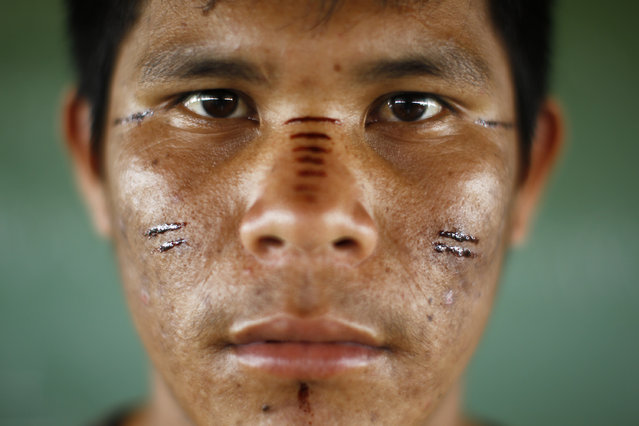
Sixteen-year-old Matasinnawana of the Yekuana indigenous Indian tribe poses at a classroom at the Indigenous University in Cano Tauca in the southern state of Bolivar May 11, 2011. The original residents of Venezuela's forests, Caribbean coves and swampy plains, dozens of Amerindian ethnic groups now make up only a fraction of the 29 million people in the South American country dominated by the oil industry. Like similar groups across the world, their habitat and way of life in a vast, long-neglected region of forests and waterways around the Orinoco river are increasingly threatened. (Photo by Jorge Silva/Reuters)
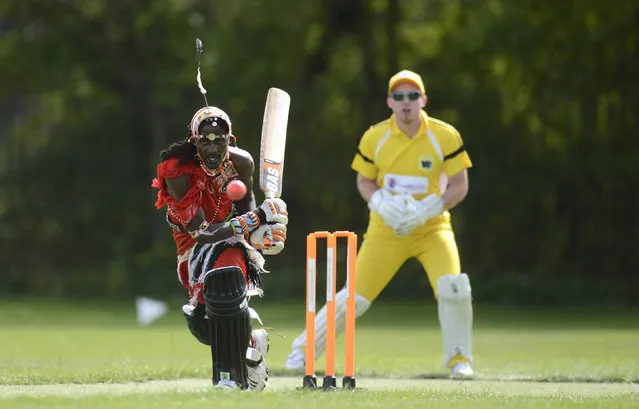
Nissan Jonathan Ole Meshami (L) of the Maasai Cricket Warriors team from Kenya hits the ball during a match against English team 'The Shed', during the “Last Man Stands” cricket tournament at Dulwich sports ground in South London September 1, 2013. (Photo by Philip Brown/Reuters)
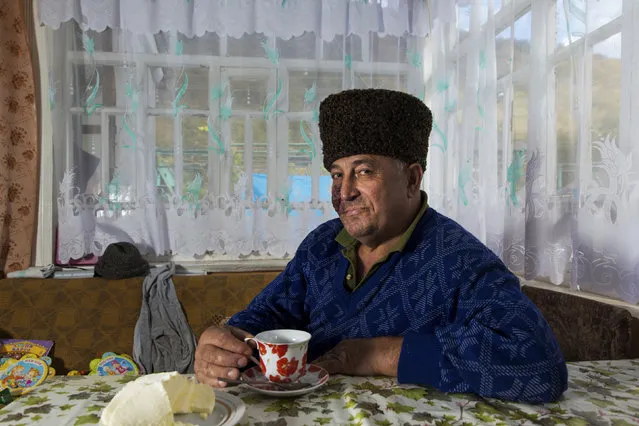
Circassian villager Ais Tlyf poses for a photograph in his kitchen in Tkhagapsh in the Lazerevskoye district of Sochi October 20, 2013. “The clan of my ancestors settled on this plain in the mountains in 1872 along with other Circassian families. It was long after the end of the Russian Caucasian war when hostilities had ceased and the Russians dismantled their military fort that used to be here”, Tlyf said. Tkhagapsh is one of the few remaining settlements in the Sochi region, that mainly consists of ethnic Circassians. Circassians are a people indigenous to the North Caucasus region, most of whom were scattered across the globe by a 19th century tsarist military campaign that caused the deaths of huge numbers. (Photo by Thomas Peter/Reuters)
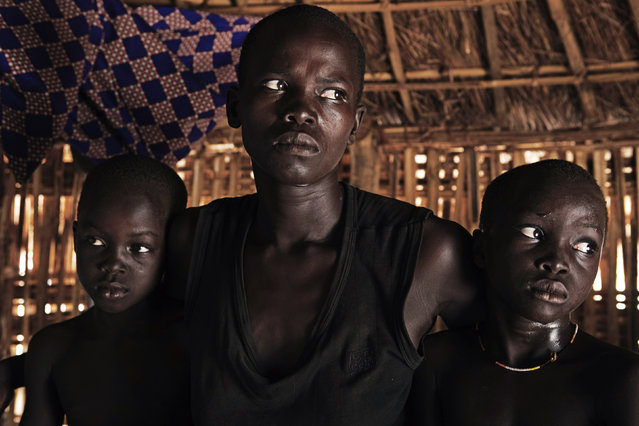
Mandelina Nyi-Bo (C), an ethnic Jur, sits in her bamboo hut with her daughters Jore (R) and Nyankuru in the remote village Dongoi in Western Equatorial State, April 7, 2010. Nyi-Bo's husband was killed in ethnic clashes with the Dinka tribewhile she fled with her children from her home village of Lamo. (Photo by Finbarr O'Reilly/Reuters)
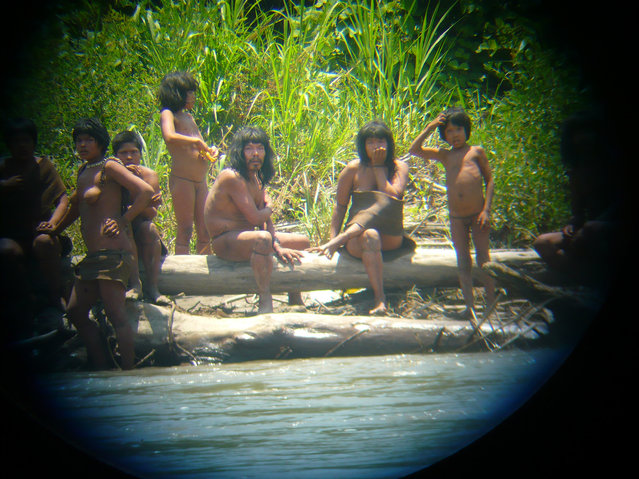
Members of the Mashco-Piro tribe observe a group of travelers from across the Alto Madre de Dios river in the Manu National Park in the Amazon basin of southeastern Peru, as photographed through a bird scope October 21, 2011. Survival International has the Mashco-Piro tribe listed as one of around 100 uncontacted indigenous tribes in the world. (Photo by Jean-Paul Van Belle/Reuters)
09 Aug 2015 10:26:00,
post received
0 comments
